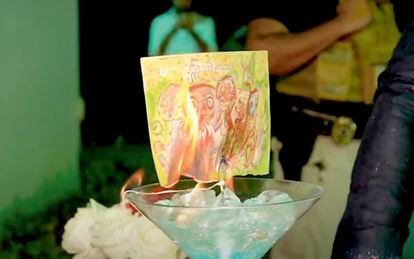Will the NFT phenomenon be nipped in the bud? | Culture

Two recent pieces of news confirm the extreme volatility of the digital non-fungible token (NFT), which has been at the center of a speculative storm in the art world. On September 27, Martín Mobarak, a private collector from Miami, burned Fantasmones Siniestros (Sinister Ghosts), an original work by Mexican artist Frida Kahlo, after digitizing it and launching 10,000 NFTs that will soon go on sale. According to Mobarak’s calculations, the digitized versions will increase in value when the physical drawing no longer exists.
Coinciding with Mobarak’s stunt, Christie’s auction house has just launched its 3.0 auction platform, focused exclusively on NFTs, and has started by putting nine works by 18-year-old activist and visual creator Diana Sinclair under the hammer. Sinclair has been wrongly defined as the Lionel Messi of modern digital art. That is, no matter how spectacular the collapse of the business model, there is no shortage of unscrupulous entrepreneurs willing to keep it afloat.
According to Noah Davis, the crypto expert whom Christie’s consulted before embarking on its foray into the NFT market, the volatility of recent months is simply due to “the fact that we are still in the embryonic stage of a new artistic tradition, something like the cave painting period, and it is still no stable criteria that allow us to separate the chaff from the wheat.” This guru of disruptive digital art believes that NFTs will soon reach their definitive consolidation phase.
To better understand the ups and downs of this market, ask yourself one question: how much is the NFT of Twitter founder Jack Dorsey’s first tweet worth today? The question is somewhat rhetorical, because the current owner, investor Hakan Estavi, who bought it for the equivalent of $2.9 million in March 2021, is putting the resale on hold until the crypto-asset market comes out of hibernation. But we have an idea of what value potential buyers are placing on it right now: $280.

Last April, Estavi put his brand new original of Dorsey’s Twitter NFT up for auction. He intended to sell it for 14,969 ethers – the major cryptocurrency equivalent of $50 million, and promised to give half of that sum to charity. But it turned out that his digital asset had lost more than 99% of its value. Far from $50 million, in today’s market it’s worth the price of dinner for two at Zuni Café, one of the San Francisco restaurants Dorsey frequents. It makes perfect sense that a platter of oysters would be worth more than a succinct text by Dorsey – “just setting up my twttr” – written back in 2006. What makes it exceptional is that it’s an NFT that represents a piece of internet history and a virtual asset with an associated certification of authenticity and proof of ownership generated using the same blockchain technology used by cryptocurrencies.
That would somehow guarantee that in a world of infinitely reproducible virtual objects, the NFT would be the original of Dorsey’s tweet, in the same way that La Gioconda – valued at $960 million – is painted by Leonardo da Vinci and kept in the Louvre museum, rather than a forgery. Of course the difference is that La Gioconda is a masterpiece of analog art, the fruit of the efforts of an individual we have considered a genius for five centuries. According to NFT investor and collector Mitch Lacsamana, the supposed original of the first tweet would only be worth “something” if “Dorsey was willing to take his buyer on a sightseeing tour of Silicon Valley,” including perhaps dinner for two at Zuni Café.
However, Lacsamana does not think it is so ridiculous that someone can pay out 69 million dollars for NFT of Every day: The first 5000 days, a work by the American artist Mike Winkelmann, better known as Beeple, at an auction at Christie’s in 2021. A single click will be enough for you to use it as your desktop background. Its current owner has a certified and exclusive link to the original, which is kept in an image bank. And he has paid a fortune for that link.
But perhaps the anecdote that best illustrates the ambivalence of the NFT market is one that emerged from the NBC television network’s studios last January. Host Jimmy Fallon wanted to give a hands-on demonstration of how up-to-date he is on digital assets and showed off his latest acquisition on air: the NFT of a Bored Ape, which had cost him a few hundred dollars. It only took a few seconds of the photo’s exposure for viewers to identify the address of Fallon’s digital asset portfolio. Screenshots began to appear on Twitter detailing the cryptocurrency transactions the presenter had made.
Having a portfolio of digital assets is the equivalent of opening a Swiss bank account that gives any other client access to your financial information. There is no privacy with regard to transactions. Theoretically, anonymity is guaranteed, because to open a crypto asset portfolio you do not need to provide a real name or a physical address. However, one small indiscretion is enough to blow your anonymity. When your assets increase in value exponentially, these disadvantages are not a concern. But when the bubble bursts, those who invested millions in digital assets that then trade at rock bottom prices have to wonder what the hell they’ve gotten themselves into.

























